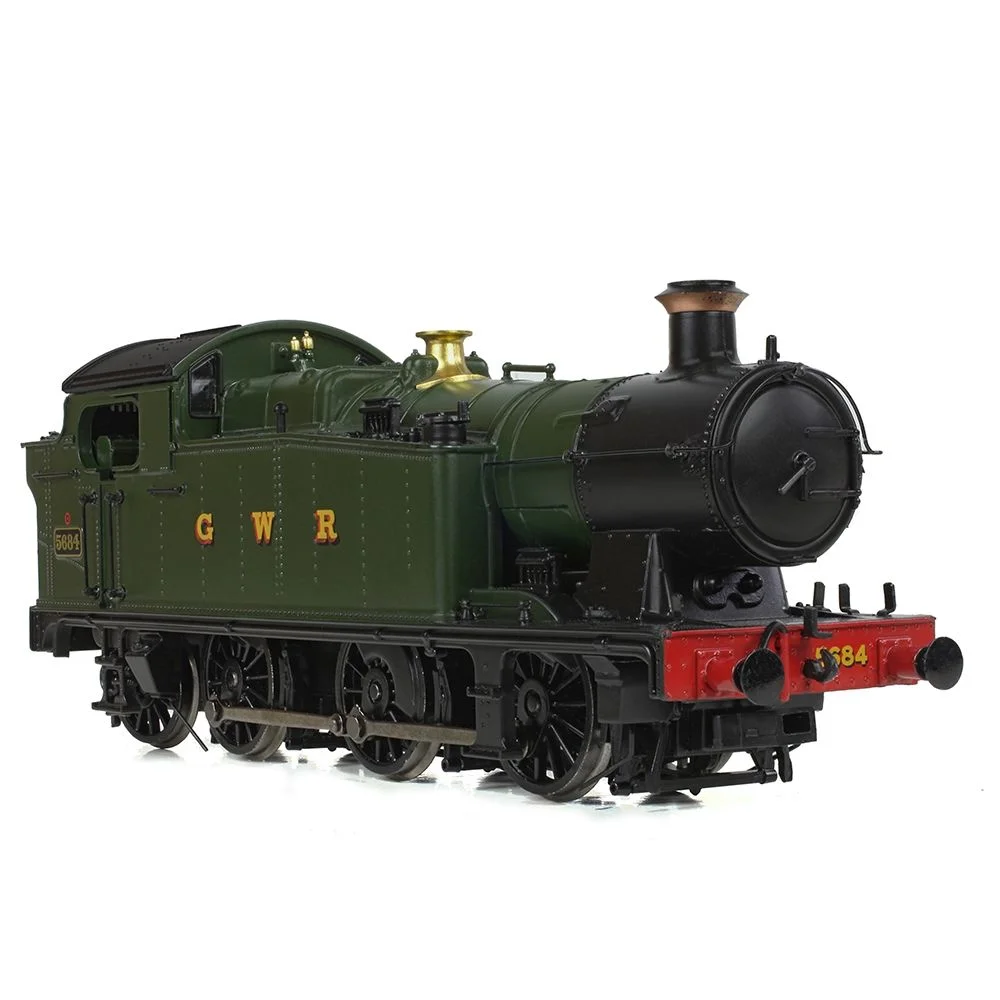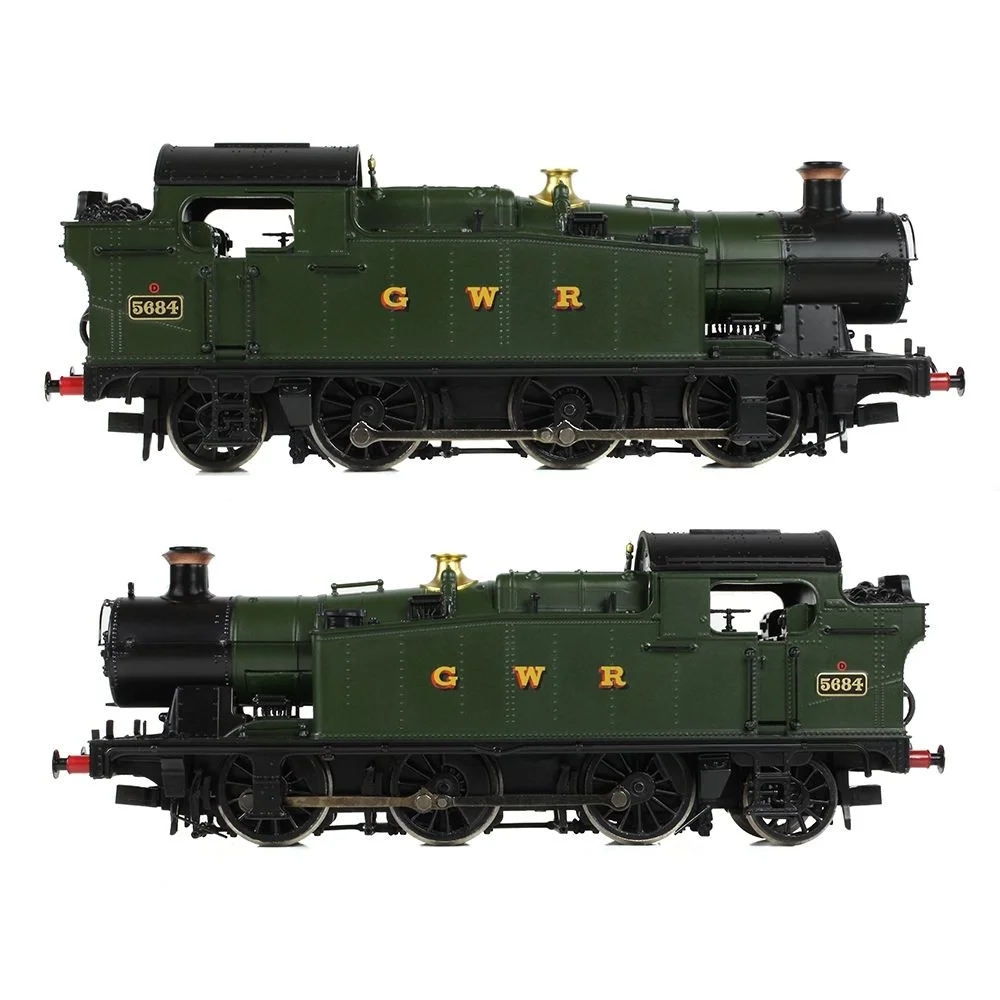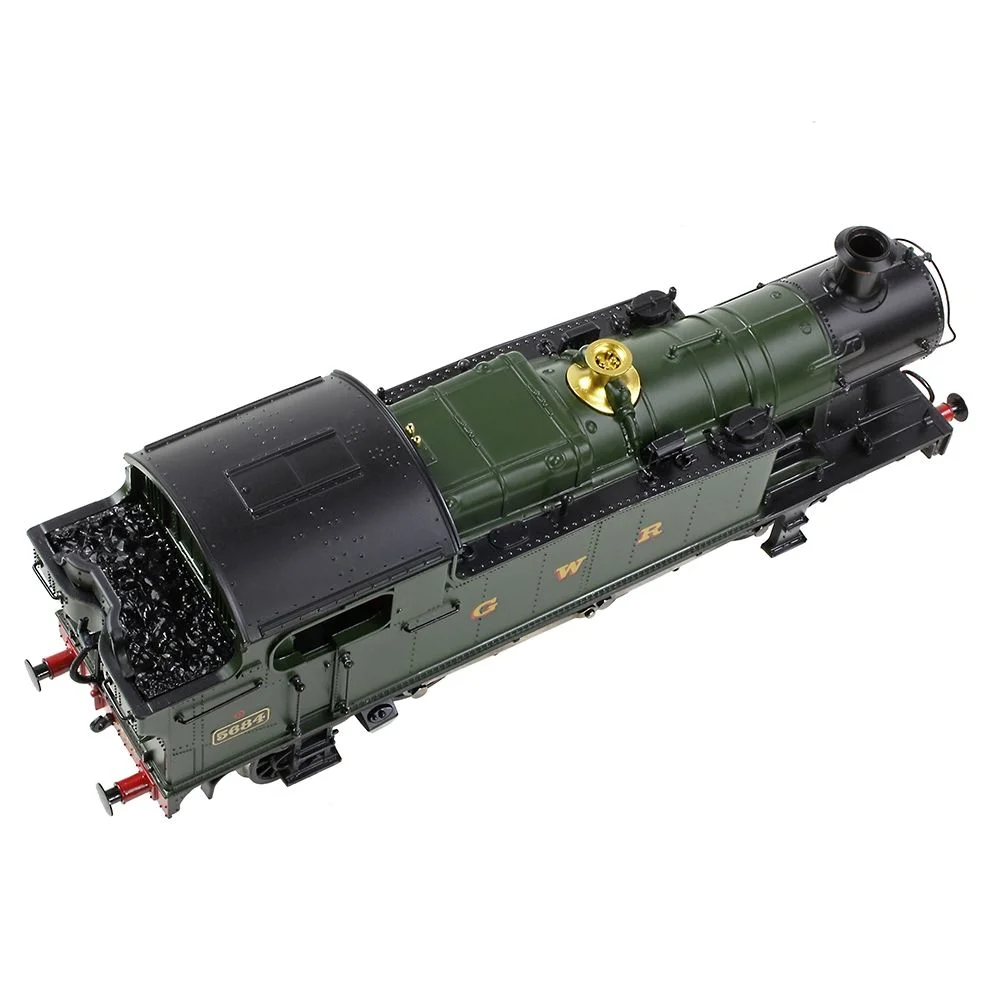Bachmann 32-084A
Great Western Railway 5600 5684 Great Western Railway Green
Tooling
In 2005, Bachmann Branchline unveiled a significant upgrade to its GWR 5600 Class 0-6-2T tank locomotive model. This retooled version replaced the 2002 release and addressed key limitations by introducing Digital Command Control (DCC) readiness and a more refined mechanism. The prototype, designed by Charles Collett and built between 1924 and 1928, was a staple of South Wales coal traffic, requiring high tractive effort and robust braking.
Tooling Features
- Scale: OO Gauge (1:76)
- Construction: Plastic bodyshell with separately fitted details; die-cast metal chassis for strength
- Detailing: Includes handrails, lamp irons, injector pipework, safety valve bonnet, smokebox door dart, water tank caps, whistle, cab glazing, and detailed cab interior
- Couplings: NEM pockets with tension-lock couplers
Mechanical & Electrical
- Motor: Powerful 3-pole motor
- Drive: Worm and gear drive to two axles
- Pickup: All wheels
- Minimum Radius: 1st radius (approx. 371 mm)
- Lighting: None
- Weighting: Internal die-cast weight for adhesion
DCC Capability
DCC Ready with an 8-pin NMRA socket, allowing easy installation of decoders. This was a major improvement over the 2002 tooling, which required hardwiring.
Liveries Produced
- GWR Green (pre-nationalisation)
- BR Green with Early Emblem (1948–1957)
- BR Black with Early Emblem (1949–1957)
- BR Green with Late Crest (1957–1972)
- BR Black with Late Crest (1957–1968)
Reviews & Commentary
The 2005 upgrade was praised for its improved detailing and digital readiness. While the motor remained a 3-pole type, Bachmann refined the gearing for smoother performance. Enthusiasts welcomed the addition of an 8-pin DCC socket, making this model far easier to convert for digital layouts. Social media and forums from the time highlight its popularity among GWR fans and its reputation as a solid mid-range steam model.
Interesting Facts
- The 5600 Class was the only 0-6-2T design built new by GWR.
- The prototype locomotives were primarily used in South Wales coal traffic, requiring high tractive effort and strong braking.
- This tooling set a benchmark for Bachmann’s approach to DCC-ready steam models in the mid-2000s.
Bachmann's Description & Specifications
The 56XX 0-6-2 Tank Locomotives were some of the GWR’s finest workhorses and we’re delighted to welcome OO Scale models of these popular machines back to the Bachmann Branchline range.
The prototype’s aura of strength and ruggedness comes across in the Branchline model which packs a punch thanks to the substantial use of diecast metal in the chassis and bunker, ensuring that this smooth-running machine can pull significant loads. Meanwhile the bodyshell is produced from precision moulded plastic components to which separate details are fitted, like the metal handrails, intricate lubricators, tank ventilators and sprung metal buffers.
The chassis, powered by a substantial 3 pole motor, carries an 8 pin DCC decoder socket and is adorned with details like the springs, brake blocks, brake rigging and sand boxes – accompanied by separate wire sandpipes. Completing the package is the livery application of rich paintwork adorned with finely printed lettering and numbering to portray this preserved locomotive at its finest.
MODEL FEATURES:
- Bachmann Branchline OO Scale
- Era 3
- Pristine GWR Green ‘GWR’ livery
- Running No. 5684
- Short Safety Valve Cover
- NEM Coupling Pockets
- Sprung Buffers
- Powerful 3 Pole Motor
- Equipped with a 8 Pin DCC Decoder Socket – Recommend Decoder item No. 36-566A
- Length 155mm (over couplings)
Class & Prototype
- Class: Great Western Railway 5600
- Traction: Steam
- Built: 1924-1928
- Total Built: 200
- Running Number: 5684
Operator & Livery
- Operator: Great Western Railway
- Livery: Green
- Era: 3 - The big 4 – LMS, GWR, LNER & SR
The Great Western Railway (1835-1947) was Britain's most innovative railway company, engineered by Isambard Kingdom Brunel with his revolutionary 7ft ¼in broad gauge system. Known affectionately as "God's Wonderful Railway" and the "Holiday Line," the GWR connected London Paddington with the West Country, Wales, and Birmingham through 3,800 miles of superbly engineered routes.
Renowned for its Brunswick green locomotives, chocolate and cream carriages, and engineering excellence centred at Swindon Works, the GWR pioneered advanced steam technology under chief mechanical engineers Daniel Gooch, George Jackson Churchward, and Charles Collett. The company's legendary locomotive classes—including Castle, King, Hall, and Manor—established performance standards that influenced British locomotive design for decades.
The only "Big Four" railway to retain its original identity through the 1921 grouping, the GWR maintained its distinctive corporate culture until nationalisation in 1947. Today, the company's engineering legacy lives on through extensive preservation efforts, heritage railways, and detailed model railway recreations that celebrate the finest traditions of British steam railway operation.





